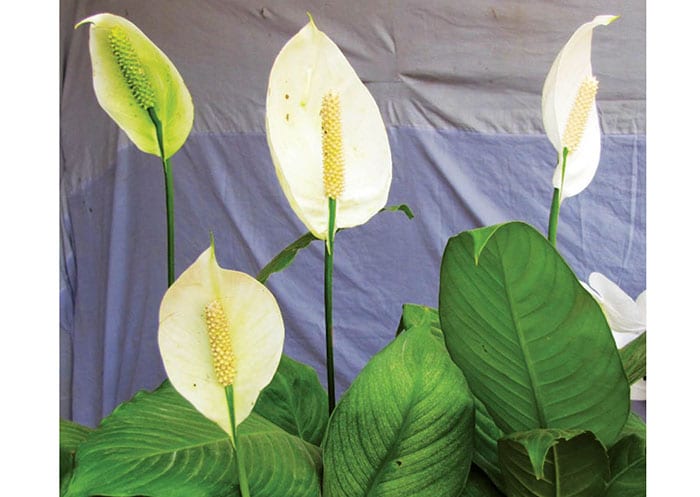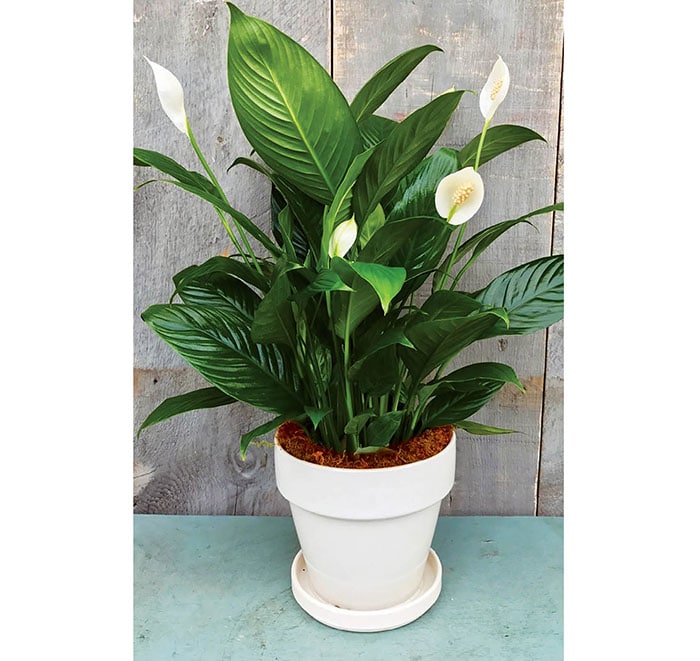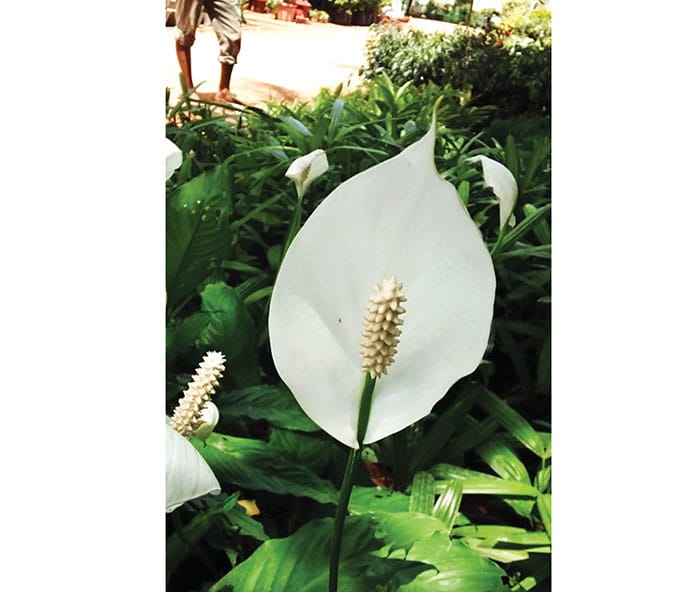Text & photographs by Dr. Mahadeswara Swamy Scientist
Peace lilies, also known as ‘Snow flower’, ‘Spathe flower’ and ‘White anthurium’, are popular house plants. They produce charming perky snow-white blooms on long stalks. The floral make-up looks like an expanded hood of a cobra, ready to strike! They provide tropical look with exotic touch and spread more grace than many a more sumptuous blooms. That is why they are peace lilies!
In addition, they combat air pollution indoors as they are capable of removing toxic gaseous chemicals from air. Around 35 species of genus Spathiphyllum belonging to the family Aeraceae, are collectively called peace lilies.
The name is derived from Greek word ‘Spath’ meaning ‘Bract or Sheath ’ and ‘Phyllum’ referring to ‘Leaf’. They are native to Central and South America, Indonesia and Philippines.

They are compact clump forming evergreen perennials up to 3 ft. height. They produce tufts of foliage from a small underground stem (rhizome). Leaves, on long petioles (leaf stalks), are more or less oval-shaped, tapering into a point inversely spear-shaped. They are dark green and glossy with many varieties with variegated foliage.
They produce blooms on long stalk far above the foliage and inflorescence is called ‘spadix’, which is made up of white or light green, fleshy cylindrical column covered with innumerable miniature sessile (stalkless) flowers. The spadix is enclosed by a large leaf like structure called ‘spathe’, oval in shape and white in colour; and often turn green with age. Seed setting is rare.
The notable species of ornamental value are S. floribundum (leaves rounded and flowers broad), S. cannaefolium (broader leaves like Canna), S. candidum (dwarf), S. patinii, S. wallisii and S. clevelandii (most floriferous with narrow and pliant leaves). Many vivacious and enchanting hybrid varieties varying from mini to giant size (6” to 6 ft.) come with fancy names like ‘mauna lona’, ‘wallisii’, ‘starlight’, ‘sensation’, ‘sierra’, sunlight’, ‘pallas’, ‘petite’, ‘cupido’, ‘jetty’, ‘sweet pablo’ and ‘tailors green’.

Propagation
They are mostly propagated by division by separating offshoots and planted in pots or in soil directly. Remove the plants with roots and transplant them to pots. The recommended soil mixture is sand, red soil, leaf mould and cow dung manure in 1:1:3:1 parts or equal parts of loam (garden soil), leaf mould and sphagnum moss (1:1:1) with a handful of charcoal and a tea spoon of bone meal. Best season for multiplication is the beginning of the winter or immediately after flowering.
Propagation by seeds is usually not practiced. Nevertheless, one can raise the seedlings in a seed pan immediately after the seeds are ripened using sand and sphagnum moss in equal proportion. Selected hybrid varieties are produced through breeding programme and tissue culture methods for commercial purposes, especially for export production in Karnataka.

Pest and Diseases
They are free from diseases and pests when indoors. But, when outdoors snails and caterpillars might damage the foliage. Remove them by hand. They also attract scales, mites and mealy bugs, besides bacterial diseases during wet season. Periodical spraying of a mixture of a common pesticide like rogor (2ml / lit) and bavistin (1g / lit) can keep the plants healthy.
Useful Tips
- They are vigorously growing excellent house plants suitable for entrance / passage especially on steps, reception lounges, drawing rooms besides shady balconies, windowsill, verandahs etc.
- They can also be grown in groups in shady areas especially under large trees.
- They go well with other foliage and flowering plants for plant arrangements.
- They make exceptionally good plants for interior decorations for a long period as they flower indoors.
- Water the plants freely when in full growth but less frequently in winter. Better avoid heavily chlorinated water, as they are sensitive to chlorine.
- Plant them in medium sized pots (8”) and repot when root growth has overfilled the containers for good appeal.
- Wherever the humidity is less keep the pots in a saucer / plate containing water. Alternatively plunge the pots in a container filled with sphagnum moss drenched in water.
- When exposed to direct sunlight (even moderate) the foliage suffers from sunburn and gets scorched. Hence, care is needed during hot summer. Spray water on the foliage 2 – 3 times during daytime.
- Wipe the leaves regularly with a damp cloth to remove accumulated dust and to retain natural lustre of foliage besides discouraging pests.
- It is not advisable to shift the plants very frequently as they do not tolerate sudden change of temperature. Also avoid keeping plants near heat source (TV, fridge etc.).
- Though the plants are very attractive, looks are deceptive like “Visha-kanye” as the plant parts are poisonous and cause stomach problem if you ingest. The sap causes skin irritation. Wash your hands with soap after handling the plants.
Gardening
They require warm and humid climate; prefer well-drained humus rich slightly moist soil but not the water-logged conditions. They need indirect, bright filtered light and humidity for maximum flower production. However, it is not the intensity but the long duration of light is the main factor for best flowering. They also perform well under low light indoor conditions. In hot and humid tropical weather conditions they are grown in shade, while in cold/ temperate conditions grown in green house or conservatory.
Mob: 97429-91057 e-mail: [email protected]








Recent Comments